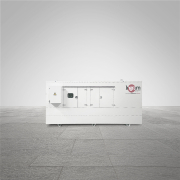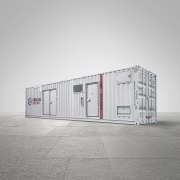Preparing Generator Sets for Extreme Environments: Deserts, Arctic Regions and More

Generator sets are essential to ensure uninterrupted power supply in remote locations, critical facilities, or areas with an unstable grid. However, when exposed to extreme conditions—scorching heat, freezing cold or high altitudes—specific solutions must be applied to guarantee optimal performance and extend equipment lifespan.
Challenges of Operating Generators in Extreme Conditions
Environmental factors can directly impact a generator’s performance, reliability and durability. Extreme temperatures, humidity, dust, and even air density at high altitudes present technical challenges that require proper equipment preparation.
The main challenges include:
- Difficult cold-weather starting.
- Overheating in arid climates.
- Loss of rated power at high altitudes.
- Increased wear on mechanical and electronic components.
- Need for reinforced cooling systems.
Overcoming these challenges demands adaptive engineering, durable materials, and an optimised configuration tailored to each environment.

Adaptations for Cold Climates: Generators in Arctic Zones
In polar or mountainous regions where temperatures drop well below zero, a standard generator may struggle to operate reliably. To ensure performance in these environments, several measures are implemented:
- Engine and fuel preheating systems, enabling starting in temperatures as low as -30 °C.
- Thermally insulated enclosures to shield internal components from extreme cold.
- Low-viscosity lubricants and fuels suitable for Arctic climates.
- Battery and alternator heaters.
These adaptations ensure that the generator can effectively meet critical energy needs, for instance in scientific bases, telecommunications infrastructure, or emergency systems in sub-Arctic areas.

Operation in High Temperatures: Solutions for Desert Environments
In desert climates—where temperatures can exceed 50 °C and dust levels are high—several parts of the generator must be reinforced:
- Oversized cooling systems, with additional fans or high-efficiency radiators to prevent overheating.
- Specialised air and dust filters to block abrasive particles from entering the engine.
- Protection of electronic components from direct solar radiation.
- UV-resistant paints and coatings.
The goal in these environments is to keep engine temperature within safe operating ranges and prevent dirt accumulation that could impair combustion or damage components.
The Importance of Cooling Systems in Extreme Conditions
Cooling systems are critical for generator sets exposed to extreme temperatures. Whether in high heat or freezing cold, efficient thermal management is essential to avoid mechanical failure, efficiency loss or irreversible engine damage.
Common cooling solutions include:
- Liquid cooling with special antifreeze for cold environments.
- Tropical-grade radiators or large-capacity heat exchangers for hot climates.
- Redundant ventilation or forced-air cooling systems.
Continuous monitoring of temperature and cooling pressure helps extend the generator’s lifespan and ensures optimal performance.

How Altitude and Air Density Affect Generator Performance
As altitude increases, air density decreases, which negatively affects combustion and, consequently, the power output of the generator. This results in:
- Reduction in rated power (up to 10% for every 1000 metres above sea level, depending on the model).
- Increased load on the intake and exhaust systems.
- Requirement for specific calibrations to adjust the air-fuel mix.
Therefore, for applications in mountainous or high plateau areas, the generator must be calibrated and fitted with systems to offset these conditions, such as tuned turbochargers or adapted electronic configurations.
Protection and Maintenance to Prolong Equipment Life
Generators designed for extreme environments require a stricter maintenance plan and additional protective measures:
- More frequent inspection of filters, oil and coolant.
- Regular checks of the electrical system and thermal insulation.
- Preventive cleaning to counteract sand, ice or salinity depending on the environment.
- Use of anti-corrosion coatings and components resistant to thermal shock.
These measures not only help avoid breakdowns, but also ensure reliable performance in the harshest conditions.
Use Cases and Applications in Critical Sectors
Generators engineered for extreme conditions are vital in sectors where power failure is not an option:
- Defence and security: military operations in desert or polar zones.
- Oil and gas: platforms or fields in remote or hostile regions.
- Emergency and rescue: humanitarian camps or temporary installations.
- Scientific exploration: Arctic research stations or desert locations like the Sahara or Atacama.
- High-altitude mining: projects in the Andes or the Himalayas.
In all these cases, generator design must meet specific power requirements with long-term reliability, performance and resilience.

Technological Trends to Enhance Generator Resilience
Technological advancements continue to improve generator resistance to extreme environments:
- Smart sensors and IoT systems for remote monitoring of operating conditions.
- Self-diagnosis systems to detect faults before they occur.
- New insulating and lightweight materials that better withstand thermal and mechanical stress.
- Compact, modular designs for easier transport and installation in remote locations.
In addition, alternative fuels such as HVO or natural gas are being integrated, offering more stable performance under certain environmental conditions.
Conclusion
Preparing a generator set for extreme conditions is not optional—it is essential to ensure operational efficiency and performance. From the Arctic to the desert, each environment demands a tailored technical approach adapted to its temperature, altitude and energy requirements. Investing in robust, well-designed and properly maintained equipment is the best way to guarantee long-term reliability.





















